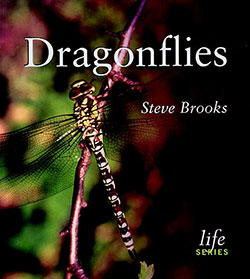Dragonflies
By Steve Brooks – (2003)
 96 pages; matt art paper, with 94 colour photographs and 12 drawings.
96 pages; matt art paper, with 94 colour photographs and 12 drawings.
Soft Cover. 23.5cm x 21cm.
ISBN: 1-58834-064-3
Smithsonian Books Washington D.C. in association with the Natural History Museum, London.
I am a big fan of this book and in fact it was one of the first I acquired on the Odonata along with “A Guide to the Dragonflies of Borneo”. This book is an excellent general introduction to these wonderful insects and after reading it, any one will feel a strong affection and indeed much closer to the covert protectors and friendly visual indicators of our planets health, the damsel and dragonflies.
This book does not concentrate on any particular group or region, but brings to life very well the history, biology, habits and habitats, different forest and other vegetative environments, the vital importance of clear running streams and rivers, territorial behavior, body types, wing and body coloration, compound eye function, mating, sexual reproduction, egg dispersal, in depth accounts of larva gill function, feeding, metamorphosis, emerging as adults, construction advice of garden ponds for Odonata and much more and of course later in the book a good broad selection of various genera and species.
It also covers the negative effects humans have on the environment through pesticides, fertilizer run off, draining of wetlands, river diversion, land clearing, logging, road building etc. bringing some of the rarer forest species and others to the brink of extinction. The author also brings to our attention the very positive attributes of the Odonata on the environment and to us humans, killing and eating very successfully mosquitos (vectors) and their larvae carrying malaria and dengue fever for one.
Further coverage includes, briefly each of the 29 families known across the globe and most accompanied by a colour photo of a representative of that particular family. Unfortunately however, there is no photo for the Anisozygopytera, the third (ancient) suborder with only 2 living species of the genus Epiophlebia.
This book is so well written in its approach, almost humble in fact, yet highly informative and captivating, that you cannot help but feel positive and warm toward these insects after reading it. As I said earlier I am a big fan of this simply presented yet enthralling book, which is an inspiration to read and all who read it will be glad they did and no doubt inspire people further, to purchase other books on the Odonata for their region and indeed hopefully take a more active role in appreciating, observing and encouraging Odonata into your garden and property and indeed theirs and other fauna’s conservation.
Rod Rice
Principal Reviewer
Nature & Travel Books
